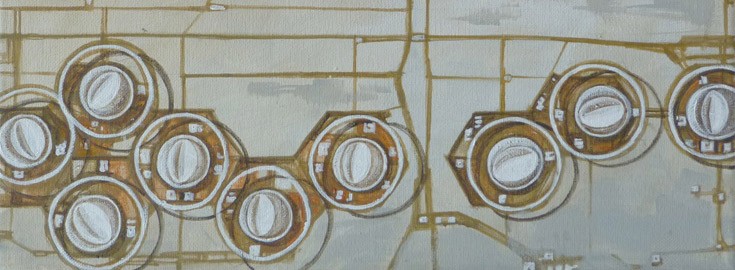
The relationship between architecture and other forms of visual art has been of exceptional importance in the development of artistic expression and creativity. From the revolutionary paintings of Pre-Renaissance artist Giotto, to Tuscan artist Piero della Francesca, we can see the foundations given by architecture in the intellectual exploration of “perspective.”
Ian Pentland is a visionary artist with a journey that takes him on a parallel course, yet unique and profoundly different. Rather than searching for lines in order to create the illusion of depth and distance, Pentland has the ability to look further through the contours, into the next dimension as an interpreter of form. Pentland’s work is a process of academic growth where the principles of artistic genius are re-discovered as well as challenged while we are introduced to an unknown and unchartered world.
The series “Unmapped” wants to break away from the status quo, to provoke thought and stimulate the viewer to question the composition in an intricate examination of our reality. The factors that contribute to the sense of intrigue are numerous; on the one hand we see Pentland’s roots as an influential architect; on the other hand however, the viewer, who may be uninformed and unfamiliar with the artist’s background, is touched by a sense of purity and perfect harmony in an unsymmetrical but wonderfully balanced composition. There is a sense of natural order and timelessness that is captured and communicated in these artworks that convey a subtle dialogue between strong use of form and shape, with an intrinsically delicate and soft nature.
The “Unmapped” series leads the viewer to imagine. The paintings are intricate abstract compositions while perhaps detailed plans for a utopian metropolis. We are offered a window into the artist’s mind where the art comes to life but Pentland is careful to create mystery, a magical distance, between what is presented to the viewer and the unknown lands that are buzzing beneath.
There has always been a strong connection between two-dimensional and three-dimensional art. Some of the greatest artists of the Renaissance drew inspiration from the study of curves and angles. Pentland’s journey is in many ways similar, albeit with one fundamental difference; the artist is studying shape as a channel to create art but also using art as a wonderful telescope through which to conceive harmony.
Timothy Warrington
European Confederation of Art Critics